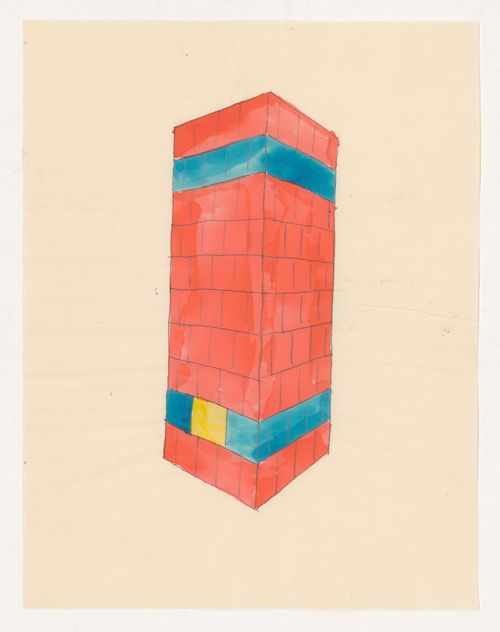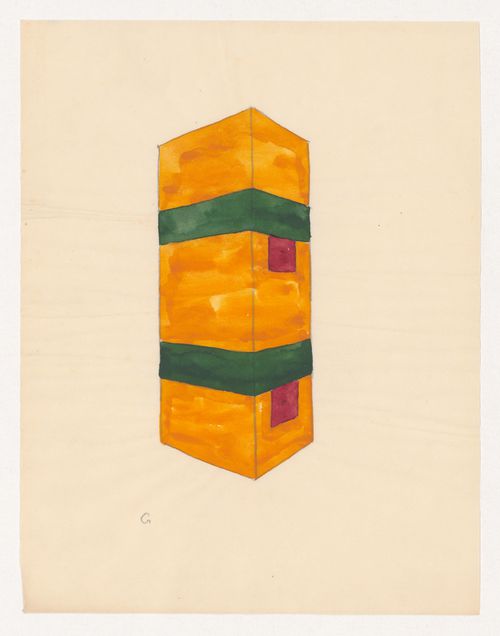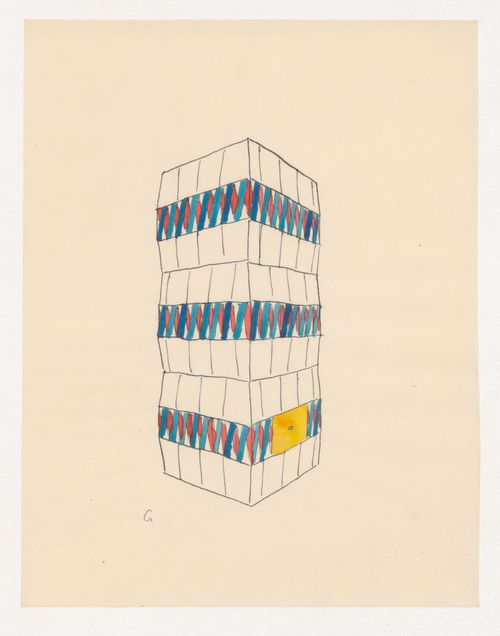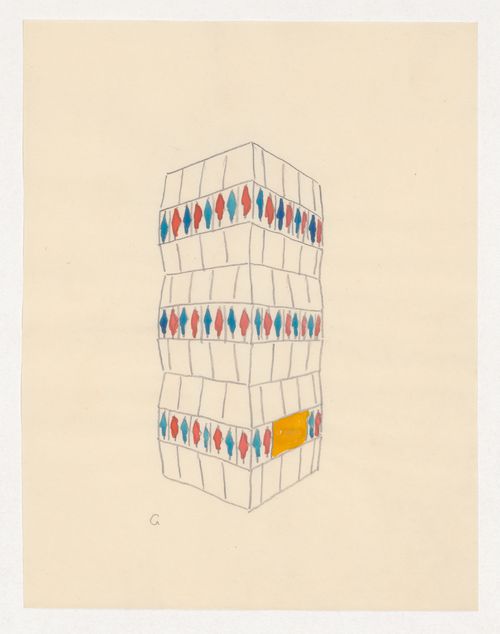DR1988:0190
Description:
- Design for a tall, rectangular tiled stove, decorated with two red horizontal bands against a blue background. The two yellow rectangles at the top and bottom probably represent the stove doors. - The subject of this drawing is identified as a tiled stove by comparison with similar drawings in the group DR1988:0155 - DR1988:0209. Several of these drawings have identifying inscriptions, such as "Ofen" (stove) and "Kachelofen" (tiled stove), which are probably by the draughtsman. Henze illustrates examples of "Kachelofen" which are similar to this one in size and proportion (fig. 105, p. 98 and fig. 114, p. 103).
interior design
circa 1920-1921
Perspective sketch for a red and blue tiled stove
Actions:
DR1988:0190
Description:
- Design for a tall, rectangular tiled stove, decorated with two red horizontal bands against a blue background. The two yellow rectangles at the top and bottom probably represent the stove doors. - The subject of this drawing is identified as a tiled stove by comparison with similar drawings in the group DR1988:0155 - DR1988:0209. Several of these drawings have identifying inscriptions, such as "Ofen" (stove) and "Kachelofen" (tiled stove), which are probably by the draughtsman. Henze illustrates examples of "Kachelofen" which are similar to this one in size and proportion (fig. 105, p. 98 and fig. 114, p. 103).
interior design
DR1988:0191
Description:
- Design for a tall, rectangular tiled stove, decorated with two blue horizontal bands against a red background. The yellow rectangle near the bottom left probably represents the stove door. - The subject of this drawing is identified as a tiled stove by comparison with similar drawings in the group DR1988:0155 - DR1988:0209. Several of these drawings have identifying inscriptions, such as "Ofen" (stove) and "Kachelofen" (tiled stove), which are probably by the draughtsman. Henze illustrates examples of "Kachelofen" which are similar to this one in size and proportion (fig. 105, p. 98 and fig. 114, p. 103).
interior design
circa 1920-1921
Perspective sketch for a red and blue tiled stove
Actions:
DR1988:0191
Description:
- Design for a tall, rectangular tiled stove, decorated with two blue horizontal bands against a red background. The yellow rectangle near the bottom left probably represents the stove door. - The subject of this drawing is identified as a tiled stove by comparison with similar drawings in the group DR1988:0155 - DR1988:0209. Several of these drawings have identifying inscriptions, such as "Ofen" (stove) and "Kachelofen" (tiled stove), which are probably by the draughtsman. Henze illustrates examples of "Kachelofen" which are similar to this one in size and proportion (fig. 105, p. 98 and fig. 114, p. 103).
interior design
DR1988:0192
Description:
- Design for a tall, rectangular tiled stove, decorated with two horizontal bands of a red and blue geometric pattern. The two yellow rectangles, at the top and bottom, probably represent the stove doors. - The subject of this drawing is identified as a tiled stove by comparison with similar drawings in the group DR1988:0155 - DR1988:0209. Several of these drawings have identifying inscriptions, such as "Ofen" (stove) and "Kachelofen" (tiled stove), which are probably by the draughtsman. Henze illustrates examples of "Kachelofen" which are similar to this one in size and proportion (fig. 105, p. 98 and fig. 114, p. 103).
interior design
circa 1920-1921
Perspective sketch for a tiled stove decorated with a red and blue geometric pattern
Actions:
DR1988:0192
Description:
- Design for a tall, rectangular tiled stove, decorated with two horizontal bands of a red and blue geometric pattern. The two yellow rectangles, at the top and bottom, probably represent the stove doors. - The subject of this drawing is identified as a tiled stove by comparison with similar drawings in the group DR1988:0155 - DR1988:0209. Several of these drawings have identifying inscriptions, such as "Ofen" (stove) and "Kachelofen" (tiled stove), which are probably by the draughtsman. Henze illustrates examples of "Kachelofen" which are similar to this one in size and proportion (fig. 105, p. 98 and fig. 114, p. 103).
interior design
DR1988:0200
Description:
- Design for a tall, rectangular tiled stove, decorated with two green horizontal bands against a dark yellow background. The two red rectangles, near the top and bottom, probably represent the stove doors. - The subject of this drawing is identified as a tiled stove by comparison with similar drawings in the group DR1988:0155 - DR1988:0209. Several of these drawings have identifying inscriptions, such as "Ofen" (stove) and "Kachelofen" (tiled stove), which are probably by the draughtsman. Henze illustrates examples of "Kachelofen" which are similar to this one in size and proportion (fig. 105, p. 98 and fig. 114, p. 103).
interior design
circa 1920-1921
Perspective sketch for a yellow tiled stove
Actions:
DR1988:0200
Description:
- Design for a tall, rectangular tiled stove, decorated with two green horizontal bands against a dark yellow background. The two red rectangles, near the top and bottom, probably represent the stove doors. - The subject of this drawing is identified as a tiled stove by comparison with similar drawings in the group DR1988:0155 - DR1988:0209. Several of these drawings have identifying inscriptions, such as "Ofen" (stove) and "Kachelofen" (tiled stove), which are probably by the draughtsman. Henze illustrates examples of "Kachelofen" which are similar to this one in size and proportion (fig. 105, p. 98 and fig. 114, p. 103).
interior design
DR1988:0202
Description:
- Design for a tall, rectangular tiled stove, decorated with brown vertical stripes against a blue background. The two orange yellow rectangles near the top and bottom probably represent the stove doors. - The subject of this drawing is identified as a tiled stove by comparison with similar drawings in the group DR1988:0155 - DR1988:0209. Several of these drawings have identifying inscriptions, such as "Ofen" (stove) and "Kachelofen" (tiled stove), which are probably by the draughtsman. Henze illustrates examples of "Kachelofen" which are similar to this one in size and proportion (fig. 105, p. 98 and fig. 114, p. 103).
interior design
circa 1920-1921
Perspective sketch for a blue and brown tiled stove
Actions:
DR1988:0202
Description:
- Design for a tall, rectangular tiled stove, decorated with brown vertical stripes against a blue background. The two orange yellow rectangles near the top and bottom probably represent the stove doors. - The subject of this drawing is identified as a tiled stove by comparison with similar drawings in the group DR1988:0155 - DR1988:0209. Several of these drawings have identifying inscriptions, such as "Ofen" (stove) and "Kachelofen" (tiled stove), which are probably by the draughtsman. Henze illustrates examples of "Kachelofen" which are similar to this one in size and proportion (fig. 105, p. 98 and fig. 114, p. 103).
interior design
DR1988:0207
Description:
- Design for a tall, rectangular tiled stove, decorated with two blue horizontal bands against a brown background. The two yellow rectangles, near the top and bottom, probably represent the stove doors. - The subject of this drawing is identified as a tiled stove by the inscription "Ofen" (stove). This inscription, probably by the draughtsman, occurs on several of the drawings in the group DR1988:0155 - DR1988:0209, as does the inscription "Kachelofen" (tiled stove). Henze illustrates examples of "Kachelofen" which are similar to this one in size and proportion (fig. 105, p.98 and fig. 114, p.103).
interior design
circa 1920-1921
Perspective sketch for a brown and blue tiled stove
Actions:
DR1988:0207
Description:
- Design for a tall, rectangular tiled stove, decorated with two blue horizontal bands against a brown background. The two yellow rectangles, near the top and bottom, probably represent the stove doors. - The subject of this drawing is identified as a tiled stove by the inscription "Ofen" (stove). This inscription, probably by the draughtsman, occurs on several of the drawings in the group DR1988:0155 - DR1988:0209, as does the inscription "Kachelofen" (tiled stove). Henze illustrates examples of "Kachelofen" which are similar to this one in size and proportion (fig. 105, p.98 and fig. 114, p.103).
interior design
DR1988:0208
Description:
- Design for a tall, rectangular tiled stove with faceted sides, decorated with three horizontal bands of a red and blue geometric pattern. The yellow rectangle near the bottom probably represents the stove door. - The subject of this drawing is identified as a tiled stove by comparison with similar drawings in the group DR1988:0155 - DR1988:0209. Several of these drawings have identifying inscriptions, such as "Ofen" (stove) and "Kachelofen" (tiled stove), which are probably by the draughtsman. Henze illustrates examples of "Kachelofen" which are similar to this one in size and proportion (fig. 105, p. 98 and fig. 114, p. 103).
interior design
circa 1920-1921
Perspective sketch for a tiled stove with faceted sides
Actions:
DR1988:0208
Description:
- Design for a tall, rectangular tiled stove with faceted sides, decorated with three horizontal bands of a red and blue geometric pattern. The yellow rectangle near the bottom probably represents the stove door. - The subject of this drawing is identified as a tiled stove by comparison with similar drawings in the group DR1988:0155 - DR1988:0209. Several of these drawings have identifying inscriptions, such as "Ofen" (stove) and "Kachelofen" (tiled stove), which are probably by the draughtsman. Henze illustrates examples of "Kachelofen" which are similar to this one in size and proportion (fig. 105, p. 98 and fig. 114, p. 103).
interior design
DR1988:0209
Description:
- Design for a tall, rectangular tiled stove with faceted sides, decorated with three horizontal bands of red and blue lozenges. The dark yellow rectangle near the bottom probably represents the stove door. - The subject of this drawing is identified as a tiled stove by comparison with similar drawings in the group DR1988:0155 - DR1988:0209. Several of these drawings have identifying inscriptions, such as "Ofen" (stove) and "Kachelofen" (tiled stove), which are probably by the draughtsman. Henze illustrates examples of "Kachelofen" which are similar to this one in size and proportion (fig. 105, p. 98 and fig. 114, p. 103).
interior design
circa 1920-1921
Perspective sketch for a tiled stove with faceted sides
Actions:
DR1988:0209
Description:
- Design for a tall, rectangular tiled stove with faceted sides, decorated with three horizontal bands of red and blue lozenges. The dark yellow rectangle near the bottom probably represents the stove door. - The subject of this drawing is identified as a tiled stove by comparison with similar drawings in the group DR1988:0155 - DR1988:0209. Several of these drawings have identifying inscriptions, such as "Ofen" (stove) and "Kachelofen" (tiled stove), which are probably by the draughtsman. Henze illustrates examples of "Kachelofen" which are similar to this one in size and proportion (fig. 105, p. 98 and fig. 114, p. 103).
interior design
Project
São Victor, Porto
CD034.S1.1974.PR04
Description:
This project series contains reproductions of photographs, drawings and panels displayed in the exhibit to document the São Victor neighbourhood, in Porto, Portugal. The exhibit text explained that: ... the group of 12 houses built for the São Victor neighbourhood was one of SAAL's most important operations, despite the fact that only a small part of the project was carried out. Maintaining the urban fabric of the 'ilhas' (islands) and their internal community ties, the São Victor design combined the responsiveness inherent in the participatory nature of the project with architectural and technical precision. An important case study, it led Álvaro Siza Vieira, the project architect, being invited to design projects in Berlin and The Hague in the following decade. In many aspects, São Victor represents an ethically and politically-minded architectural practice, with a stress on understanding the link between being responsive to the voice of the people and the permanence of architectural design. (The SAAL Process, Housing in Portugal 1974–76) Álvaro Siza worked for SAAL/North with Adalberto Dias, Domingos Tavares, Eduardo Souto de Moura, Francisco Guedes, Graça Nieto, Manuel Borges, Manuela Sambade, Paula Cabral and the residents' association S. Victor, that was founded on April 14th, 1975. The first phase of the project included 32 dwellings and the second, 20 dwellings. The operation began in November 1974, with a construction date in October 1975. This project series contains reproductions of design development drawings, exhibition panels and photographs. The original material was produced around 1974-1975 and were reproduced in 2015 for the exhibit.
circa 1974-1975
São Victor, Porto
Actions:
CD034.S1.1974.PR04
Description:
This project series contains reproductions of photographs, drawings and panels displayed in the exhibit to document the São Victor neighbourhood, in Porto, Portugal. The exhibit text explained that: ... the group of 12 houses built for the São Victor neighbourhood was one of SAAL's most important operations, despite the fact that only a small part of the project was carried out. Maintaining the urban fabric of the 'ilhas' (islands) and their internal community ties, the São Victor design combined the responsiveness inherent in the participatory nature of the project with architectural and technical precision. An important case study, it led Álvaro Siza Vieira, the project architect, being invited to design projects in Berlin and The Hague in the following decade. In many aspects, São Victor represents an ethically and politically-minded architectural practice, with a stress on understanding the link between being responsive to the voice of the people and the permanence of architectural design. (The SAAL Process, Housing in Portugal 1974–76) Álvaro Siza worked for SAAL/North with Adalberto Dias, Domingos Tavares, Eduardo Souto de Moura, Francisco Guedes, Graça Nieto, Manuel Borges, Manuela Sambade, Paula Cabral and the residents' association S. Victor, that was founded on April 14th, 1975. The first phase of the project included 32 dwellings and the second, 20 dwellings. The operation began in November 1974, with a construction date in October 1975. This project series contains reproductions of design development drawings, exhibition panels and photographs. The original material was produced around 1974-1975 and were reproduced in 2015 for the exhibit.
Project
circa 1974-1975
Series
Architectural projects
AP164.S1
Description:
This series documents the architectural projects of Ábalos&Herreros from 1986 to 2006 and represents over 150 projects, including exhibitions. The firm worked on a wide variety of projects from commercial and residential structures to libraries and sewage treatment plants. The firm's design process was research oriented and involved conversations between Ábalos and Herreros, office collaborators, artists who partook in the projects, as well as other architects. Several projects found in this series were developed in collaboration with other architects including: José Manuel Ábalos; Salvador Pérez Arroyo; Filippo Costi; Ángel Jaramillo Esteban; Javier Fresneda; Eduardo Horta; Martín Marciano; Ángel Jaramillo Sánchez; Renata Sentkiewicz; and Héctor Vigliecca. Most projects were designed for the city of Madrid and the Community of Madrid. Projects were also developed for other sites in Spain, including the Canary Islands, as well as for sites in Portugal, Germany, the United States, and Brazil. Ábalos & Herreros often created new projects from the firm's existing work. The firm also identified their projects numerically. These identification numbers are documented at the project series level for each project. Among the materials documenting the firm's projects are conceptual, design development, presentation, and working drawings, as well as panels. There are also several CAD drawings and prints of born digital drawings. Documenting the firms conceptual process are collages and photomontages. Photographic materials included in this series depict project sites and built projects. Also included are a variety of research reference materials, correspondence, project documentation, and project submissions. Although creating models was not a common practice for the firm, there are a few project series which include models.
1953-2009
Architectural projects
Actions:
AP164.S1
Description:
This series documents the architectural projects of Ábalos&Herreros from 1986 to 2006 and represents over 150 projects, including exhibitions. The firm worked on a wide variety of projects from commercial and residential structures to libraries and sewage treatment plants. The firm's design process was research oriented and involved conversations between Ábalos and Herreros, office collaborators, artists who partook in the projects, as well as other architects. Several projects found in this series were developed in collaboration with other architects including: José Manuel Ábalos; Salvador Pérez Arroyo; Filippo Costi; Ángel Jaramillo Esteban; Javier Fresneda; Eduardo Horta; Martín Marciano; Ángel Jaramillo Sánchez; Renata Sentkiewicz; and Héctor Vigliecca. Most projects were designed for the city of Madrid and the Community of Madrid. Projects were also developed for other sites in Spain, including the Canary Islands, as well as for sites in Portugal, Germany, the United States, and Brazil. Ábalos & Herreros often created new projects from the firm's existing work. The firm also identified their projects numerically. These identification numbers are documented at the project series level for each project. Among the materials documenting the firm's projects are conceptual, design development, presentation, and working drawings, as well as panels. There are also several CAD drawings and prints of born digital drawings. Documenting the firms conceptual process are collages and photomontages. Photographic materials included in this series depict project sites and built projects. Also included are a variety of research reference materials, correspondence, project documentation, and project submissions. Although creating models was not a common practice for the firm, there are a few project series which include models.
Series
1953-2009







